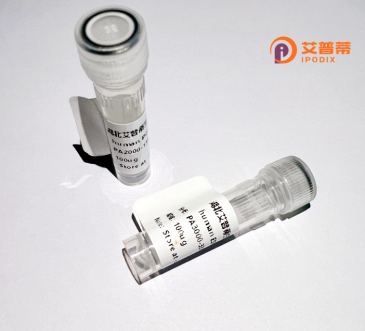
| 纯度 | >90%SDS-PAGE. |
| 种属 | Human |
| 靶点 | SEPT4 |
| Uniprot No | O43236 |
| 内毒素 | < 0.01EU/μg |
| 表达宿主 | E.coli |
| 表达区间 | 1-478 aa |
| 活性数据 | MDRSLGWQGN SVPEDRTEAG IKRFLEDTTD DGELSKFVKD FSGNASCHPP EAKTWASRPQ VPEPRPQAPD LYDDDLEFRP PSRPQSSDNQ QYFCAPAPLS PSARPRSPWG KLDPYDSSED DKEYVGFATL PNQVHRKSVK KGFDFTLMVA GESGLGKSTL VNSLFLTDLY RDRKLLGAEE RIMQTVEITK HAVDIEEKGV RLRLTIVDTP GFGDAVNNTE CWKPVAEYID QQFEQYFRDE SGLNRKNIQD NRVHCCLYFI SPFGHGLRPL DVEFMKALHQ RVNIVPILAK ADTLTPPEVD HKKRKIREEI EHFGIKIYQF PDCDSDEDED FKLQDQALKE SIPFAVIGSN TVVEARGRRV RGRLYPWGIV EVENPGHCDF VKLRTMLVRT HMQDLKDVTR ETHYENYRAQ CIQSMTRLVV KERNRNKLTR ESGTDFPIPA VPPGTDPETE KLIREKDEEL RRMQEMLHKI QKQMKENY |
| 分子量 | 55.0 kDa |
| 蛋白标签 | His tag N-Terminus |
| 缓冲液 | PBS, pH7.4, containing 0.01% SKL, 1mM DTT, 5% Trehalose and Proclin300. |
| 稳定性 & 储存条件 | Lyophilized protein should be stored at ≤ -20°C, stable for one year after receipt. Reconstituted protein solution can be stored at 2-8°C for 2-7 days. Aliquots of reconstituted samples are stable at ≤ -20°C for 3 months. |
| 复溶 | Always centrifuge tubes before opening.Do not mix by vortex or pipetting. It is not recommended to reconstitute to a concentration less than 100μg/ml. Dissolve the lyophilized protein in distilled water. Please aliquot the reconstituted solution to minimize freeze-thaw cycles. |
以下是关于重组人SEPT4蛋白的3篇代表性参考文献,简要汇总如下:
1. **文献名称**:*SEPT4 modulates β-amyloidogenesis through C-terminal binding of β-secretase and stabilization of BACE1*
**作者**:Takehiko Ueyama et al.
**摘要**:研究利用重组SEPT4蛋白揭示其C端结构域与β-分泌酶(BACE1)的相互作用,发现SEPT4通过稳定BACE1增强β-淀粉样蛋白生成,提示其在阿尔茨海默病病理中的作用。
2. **文献名称**:*Biochemical characterization of human septin 4 (SEPT4) reveals a GTP-dependent polymer formation*
**作者**:Esther M. Tarrant et al.
**摘要**:通过重组表达纯化的SEPT4蛋白,发现其具有GTP酶活性并依赖GTP形成多聚体结构,揭示了其在细胞骨架动态调控中的潜在机制。
3. **文献名称**:*Septin 4 interacts with α-synuclein in Parkinson’s disease pathology*
**作者**:Koichi Tanaka et al.
**摘要**:重组SEPT4蛋白与α-突触核蛋白共孵育实验表明,两者在体外形成复合物,提示SEPT4可能通过影响α-突触核蛋白聚集参与帕金森病发展。
4. **文献名称**:*The role of SEPT4-USP6 fusion gene in leukemogenesis: Insights from recombinant protein analysis*
**作者**:Jianmin Li et al.
**摘要**:利用重组SEPT4-USP6融合蛋白研究其在白血病细胞中的功能,发现融合蛋白通过异常激活NF-κB通路促进细胞增殖和凋亡抵抗。
**说明**:若需具体文献原文链接或补充信息,建议通过PubMed或期刊数据库进一步检索相关标题和作者。
SEPT4. also known as Septin-4. is a member of the septin family of GTP-binding proteins that play essential roles in cytoskeletal organization, cell division, and membrane dynamics. Septins are conserved from yeast to humans and typically form filamentous structures by polymerizing into hetero-oligomeric complexes. SEPT4 encodes two major splice variants (SEPT4-BART and SEPT4-ARTS) through alternative transcription initiation sites, with molecular weights ranging from 50 to 60 kDa. Structurally, it contains a central GTPase domain flanked by polybasic regions and a coiled-coil domain critical for protein interactions.
Functionally, SEPT4 participates in diverse cellular processes, including cytokinesis, vesicle trafficking, and apoptosis regulation. It shows enriched expression in the brain and testes, where it associates with synaptic vesicles and contributes to neuronal development, synaptic plasticity, and sperm maturation. Notably, SEPT4 interacts with PARK7 (DJ-1), a protein implicated in Parkinson’s disease, suggesting a potential neuroprotective role. In apoptosis, the ARTS isoform specifically induces caspase activation by antagonizing XIAP, an apoptosis inhibitor.
Dysregulation of SEPT4 has been linked to neurodegenerative disorders (e.g., Alzheimer’s and Parkinson’s diseases) and cancers, where it may act as either a tumor suppressor or promoter depending on cellular context. Its roles in mitochondrial dynamics and stem cell regulation are emerging research frontiers. Despite progress, the precise molecular mechanisms and therapeutic potential of SEPT4 remain under active investigation.
×